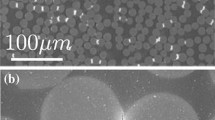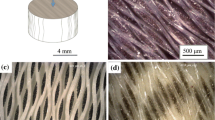A technique for determining the shear strength at the fiber–matrix interface was developed. The experiments used the copolymer of para-aramid fiber Rusar C (Termotex SPC) and a polymer composite based on KDA epoxide resin. The limiting strength was found to be 105.2 MPa. The dependence of the strength of single filaments on the clamping length, thread strength, and strength of a microplastic fabricated from this thread were used as the input information.
Similar content being viewed by others
Explore related subjects
Discover the latest articles, news and stories from top researchers in related subjects.Avoid common mistakes on your manuscript.
The strength properties of a matrix material in layers in direct contact with the surface of a filler are highly significant for determining the filler properties in a composite material (CM). Several destruction mechanisms of organic plastics are known [1], one of which involves stratification along a fiber at the matrix or the matrix–fiber interface. In this case, the shear strength of the matrix at the boundary with the fiber should be known as a minimum to predict the CM properties. Currently, this characteristic is determined by unique methods using expensive equipment.
Many experimental data were obtained in various laboratories by four different methods for single filaments of Courtaulds XA carbon fiber (Courtaulds, UK) and MY750 epoxide resin (Ciba-Geigy) [2]. In all instances, the resin was hardened by the same method. The limiting strength was found in the range from 34 to 103 MPa. Such large-scale work was not found for aramid fibers. Strengths in the range 40-57 MPa for aramid SVM fiber and various epoxide resins (ED 10, UP-2218, EKhD-MK, EDF, 5-211 B) and 44 MPa for Kevlar fiber and ED 10 were reported [1].
Tensile testing of a composite material found that filaments of a fibrous filler fractured before a certain size, less than which elemental fibers were not observed [3]. The term critical length was proposed for this size. The critical length δ0, filament strength σ, shear strength of the matrix at the boundary of the fiber τ, and filament diameter df are related by the equation
The variables should be experimentally determined. The strength of organic fibers depends on a set of measurements. Therefore, the strength σ in Eq. (1) should be determined for a clamping length equal to δ0. Typical values of this parameter are <1 mm. However, determination of the strength at this clamping length is problematical. Extrapolation of experimental data obtained for clamping lengths in the range 10-50 mm was used in the present work. The numerical value of the critical length was determined using the equation recommended for organic plastics [4]:
where L is the clamping length; σL, strength of a complex thread measured at clamping length L; σm, microplastic strength; and β, Weibull distribution shape parameter for complex thread strength measured at clamping length L.
The complex thread Rusar C (Termotex SPC) and a composite of KDA epoxide resin were used to prepare a microplastic in the present work. The strengths of the complex thread and microplastic were determined at the same clamping length of 70 mm. The microplastic was prepared and all strength measurements were made in scientific subdivisions of Termotex SPC. Figure 1 shows measurements in increasing order for better clarity.
The ability to use the Weibull distribution to approximate the measured strengths of the complex threads and single filaments of aramid fibers, including after surface treatment of the fiber with multi-layered carbon nanotubes, was demonstrated before [5,6,7,8,9].
The Weibull distribution function for strength F(σ) is written
where ma is a scale factor and β, a shape parameter.
The numerical values of these parameters were determined using the generally accepted maximum probability principle. The values of the distribution parameters were ma = 4.4927 and β = 13.3031. Figure 2 shows an empirical distribution function of thread strength that was built only from experimental data without including model representations and Weibull distribution function parameters calculated from these values.
Empirical distribution function (stepped curve) for thread strength and distribution function calculated using Eq. (3) with ma = 4.4927 and β = 13.3031.
The critical length (δ0, mm) could be determined by substituting into Eq. (2) the obtained shape and scale parameters:
The strength of a filament σ that appeared in Eq. (1) was determined using extrapolation of the dependence of the logarithm of filament strength on the logarithm of the clamping length. Filament strengths were measured at clamping lengths 10, 20, 30, and 40 mm. A total of 30 parallel measurements were made for each clamping length. Figure 3 shows a graph illustrating the results.
Least-squares processing determined the following approximation function:
The logarithmic function [Eq. (4)] approximated the experimental data with high accuracy. It was previously established [10] that this was a consequence of the Weibull distribution being adequate for the experimental data. Substitution into Eq. (4) of critical length δ0 = 0.4688 mm produced a strength of 6.281 GPa. The average diameter of the filaments for the studied sample was 15.7 μm. Substitution of these values into the right part of Eq. (1) gave a shear strength of the matrix at the interface with the fiber (τ, GPa) of
References
E. S. Zelenskii, A. M. Kuperman, et al., Ross. Khim. Zh., XLV, No. 2, 56-74 (2001).
M. J. Pitkethly et al., Compos. Sci. Technol., 48, No. 1-4, 205-214 (1993).
A. Kelly and W. R. Tyson, J. Mech. Phys. Solids, 13, No. 6, 329-350 (1965).
S. L. Bazhenov, A. A. Berlin, et al., Khim. Volokna, No. 1, 27-29 (1989).
C. Ulianov, A. Robinson, et al., Plast., Rubber Compos., 39, No. 3-5, 157-164 (2010).
S. M. Shebanov, I. K. Novikov, et al., Mech. Compos. Mater., No. 49 (4), 477-479 (2020) [53, No. 2, 267-270 (2017)].
S. M. Shebanov, I. K. Novikov, and I. A. Gerasimov, Fibre Chem., 51, No. 6, 477-479 (2020).
S. M. Shebanov, Mech. Compos. Mater., 57, No. 2, 269-272 (2021).
S. M. Shebanov, I. K. Novikov, et al., Fibre Chem., 53, No. 4, 277-282 (2022).
M. S. Shebanov, V. B. Ivanov, et al., Russ. J. Gen. Chem., 92, No. 3, 526-529 (2022).
Author information
Authors and Affiliations
Corresponding author
Additional information
Translated from Khimicheskie Volokna, No. 4, pp. 26-28, July—August, 2022.
Rights and permissions
Springer Nature or its licensor (e.g. a society or other partner) holds exclusive rights to this article under a publishing agreement with the author(s) or other rightsholder(s); author self-archiving of the accepted manuscript version of this article is solely governed by the terms of such publishing agreement and applicable law.
About this article
Cite this article
Shebanov, M.S., Bova, V.G., Shiyanova, L.B. et al. Determination of Shear Strength at the Fiber–Matrix Interface in an Organic Plastic. Fibre Chem 54, 240–242 (2022). https://doi.org/10.1007/s10692-023-10385-y
Published:
Issue Date:
DOI: https://doi.org/10.1007/s10692-023-10385-y







